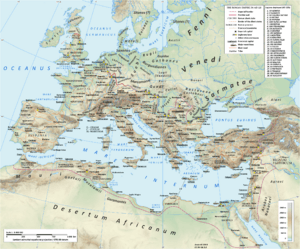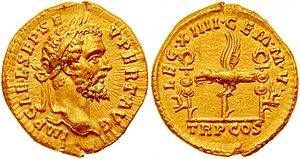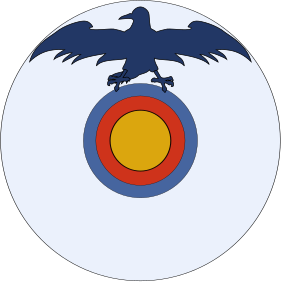Legio XIV Gemina facts for kids
Quick facts for kids Legio XIV Gemina Martia Victrix |
|
|---|---|

|
|
| Active | 41 BC to early 5th century at least |
| Country | Roman Republic (1st & 2nd raising under Caesar, 2nd Triumvirate) Roman Empire (3rd raising was a joining with another understrength legion under Octavian after the Battle of Actium) |
| Type | Roman legion (Marian) (with Imperial modifications) later a comitatensis unit |
| Role | Heavy Infantry (occasionally cavalry support when operating independently) |
| Size | Varied over unit lifetime. Approx. 3,500 fighting men + support at the time of creation, ~ 5,000 to 6,000 men when operating independently during Imperial period. |
| Garrison/HQ | Moguntiacum (9–43) Vindobona (92–106) Carnuntum (106–5th century) |
| Nickname(s) | Gemina Martia Victrix, "Twinned Martial and Victorious" Martia Victrix, "martial and victorious" (added by Augustus) Pia VI Fidelis VI, "six times faithful, six times loyal" (added by Gallienus) |
| Mascot(s) | Capricorn |
| Engagements | Gallic Wars (58–51 BC) Caesar's Civil War (49–45 BC) Post-Caesarian civil war (44 BC) Liberators' civil war (44–42 BC) Sicilian revolt (44–36 BC) Perusine War (41–40 BC) Final War of the Roman Republic (32–30 BC) Roman conquest of Britain (43) Year of the Four Emperors (69) revolt of Saturninus (89) Dacian Wars (101–106) Verus Parthian campaign (161–166) Marcus Aurelius Marcomannic campaign (168–180) Septimius Severus rise to power (193–194) Severus Parthian campaign (198) vexillationes of the 14th participated in many other campaigns. |
The Legio XIV Gemina ("The Twinned Fourteenth Legion") was a famous Roman legion. It was created by Julius Caesar in 57 BC. The name Gemina (Twinned) was added later. This happened when the legion joined with another smaller legion. The name Martia Victrix (martial and victorious) was given after their brave service in the Pannonian War around AD 9. They also earned it by defeating Boudicca in AD 61. The symbol of this legion was the Capricorn. This was a common symbol for legions Caesar created.
Contents
History of the Fourteenth Legion
Under Julius Caesar
The Legio XIV was first formed by Caesar in northern Italy. This was during his campaigns to conquer Gaul, which is modern-day France. Soldiers in the Roman Republic usually served for 16 years. In its early days, the legion often stayed behind to guard the camp.
Sadly, the legion suffered a big loss at Atuatuca in what is now Belgium. This happened during a revolt led by Ambiorix. The legion was quickly rebuilt. For a while, it was seen as unlucky. However, its honor was saved by its flag-bearer, Lucius Petrosidius.
Fighting with Germanicus
This legion later fought under the general Germanicus Julius Caesar. They battled against a Germanic leader named Arminius. About ten years before this, Arminius had destroyed three Roman legions. This was a huge disaster for the Roman army. The Legio XIV helped Germanicus win a victory. This win earned Germanicus a special parade called a triumph.
The Roman Invasion of Britain
From AD 9, the Legio XIV Gemina Martia Victrix was stationed in Moguntiacum, a Roman city in what is now Germany. In AD 43, it was one of four legions that helped Aulus Plautius and Claudius invade Roman Britain.
The legion built its main camp, called a castra, at Mancetter. This was on a Roman road called Watling Street. By AD 58, their base had moved to Wroxeter.
The legion played a key role in defeating Boudicca around AD 60 or 61. At the Battle of Watling Street, the 14th Legion, with about 10,000 soldiers, defeated Boudicca's much larger force. This victory made them Emperor Nero's "most effective" legion. Nero kept them in Britain for a few years to keep the local tribes under control.
In AD 67, the legion was sent to the Balkans. This was to prepare for a war against the Parthian Empire. However, this war never happened.
Rebellion on the Rhine River
In AD 89, the governor of a Roman province in Germany, Lucius Antonius Saturninus, rebelled against Emperor Domitian. The Legio XIV and another legion, the XXI Rapax, supported him. But the rebellion was put down.
When the XXIst legion was lost in AD 92, the XIV Gemina was sent to Pannonia. This is a region in Central Europe. They set up camp in Vindobona, which is modern-day Vienna. After wars with the Sarmatians and Trajan's Dacian Wars (AD 101–106), the legion moved to Carnuntum. They stayed there for three centuries. Smaller groups of soldiers from the Fourteenth Legion, called vexillations, fought in other wars. They fought against the Mauri and in a campaign against the Parthians. Emperor Marcus Aurelius even set up his headquarters in Carnuntum during his war against the Marcomanni.
Supporting Septimius Severus
In AD 193, after the death of Emperor Pertinax, the commander of the Fourteenth Legion, Septimius Severus, was declared emperor by the legions in Pannonia. His own legion, the XIV Gemina, strongly supported him. The XIV Gemina fought for Severus as he marched to Rome to defeat another leader, Didius Julianus. They also helped defeat Pescennius Niger in AD 194. It's likely they fought in the Parthian campaign that ended with the capture of the Parthian capital, Ctesiphon, in AD 198.

Supporting Different Emperors
During a time of trouble after Emperor Valerian was defeated, the XIV Gemina supported different leaders. They first supported a rebel named Regalianus against Emperor Gallienus in AD 260. Then they supported Gallienus against another rebel, Postumus. For their loyalty, they earned the title VI Pia VI Fidelis, meaning "six times faithful, six times loyal." After Gallienus died, they supported a Gallic Emperor named Victorinus.
The 5th Century and Beyond
At the start of the 5th century, the XIV Gemina was still based at Carnuntum. It likely disbanded when the Roman defenses along the Danube River collapsed around the AD 430s. A Roman document called the Notitia Dignitatum mentions a unit called the Quartodecimani. This unit was a type of mobile army unit. It's possible that this unit was a part of the old XIV Gemina legion.
See also
- List of Roman legions


